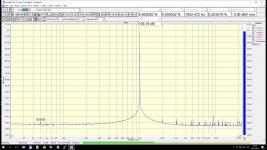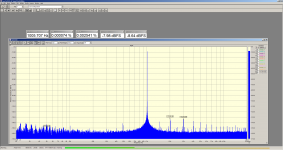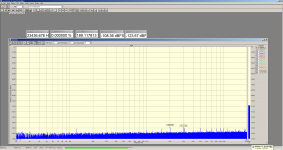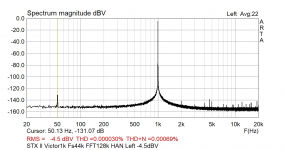The three numbers on the right are a bit confusing. I assume that the -12.5dBFS is correct.
But with dBc (decibels relative to the carrier) on the left axis, the fundamental is scaled to 0dB. I just tried it on REW V5.19.
correct, H1 at 0dBc (H1 -12.5dB full scale)
Last edited:
How much does frequency of such a top quality analog oscillator drift in time, after warming up?
HTML:
CS5381 in my ASUS STX II, oscillator Victor1k;as Victor wrote, -130dBThe Asus STX II is measured on Audio Science Review:
Review and Measurements of Asus STX II PCI Sound Card | Audio Science Review (ASR) Forum
with conclusion "The Asus STX II despite looking otherwise, has a number of serious engineering problems"
The claim of 124 dB for dynamic range - measured only 96 dB?
I wonder if that guy measures with balanced inputs. I saw a few really weird results which clearly showed a ground loop in his setup. Proper measuring a desktop PC soundcard with grounded equipment using unbalanced inputs is next to impossible.
How it can be?HTML:CS5381 in my ASUS STX II, oscillator Victor1k;as Victor wrote, -130dB
The Asus STX II is measured on Audio Science Review:
Review and Measurements of Asus STX II PCI Sound Card | Audio Science Review (ASR) Forum
with conclusion "The Asus STX II despite looking otherwise, has a number of serious engineering problems"
The claim of 124 dB for dynamic range - measured only 96 dB?
they measured DAC , I showed ADC performance at -12.5dBFS with external analog oscillator.
and yes, STX II DAC (line out) is quite bad
Last edited:
Seems that the M-audio Audiophile 192 uses AKM 5385A. It is the same as in my E-MU 0202. The E-MU can do around -125dB at mid frequencies, and slightly worse at high. You can choose the best channel - may be a little difference. Also needs to discover the best level for the input signal. If the hum and noise is a problem, then may needs to modify the schematic at the ADC chip input, but this may be not so easy...
Thanks for your reply Viktor,
So the M-Audio appears to be not so bad 🙂
I usually aim to hit a sweet spot of about -6 to -5 dBFS as this is the minimum self distortion when measuring on loopback. It measures to 1 Volt RMS. I had not thought of swopping channels - Thanks, I'll give it a try
Regards
Mike
if you are doing loopback, try going lower level + long FFT window, choose coherent frequency (multiply of sample rate and window length and then disable window function (rectangular, none) (Coherent sampling - Wikipedia ):
Cycles = round(F_OLD * FFT_Length / Fs)
F_New = Cycles * Fs / FFT_Length
Cycles could be rounded to prime number for good testing of every DAC's bit code, or power of 2 for least tested codes.
You don't have to use the exact FFT length you are measuring with, but "not higher than" of actual FFT length. in power of 2s (for example it's ok to calculate with 32768 when performing FFT=65536 measurement but not vice-versa).
Lowering the level of signal might noticeably help in certain cases 🙂 Many nice things happen when the signal goes low (dithering by noise, better linearity of converters and analog circuits etc). try -20, -40dB FS and dig into the noise.
Don't forget that if you don't see harmonics over the noise, it means they are at least -6dB lower than the displayed noise floor. If you see harmonics 6dB above the noise floor, they are actually in level with noise floor.
Cycles = round(F_OLD * FFT_Length / Fs)
F_New = Cycles * Fs / FFT_Length
Cycles could be rounded to prime number for good testing of every DAC's bit code, or power of 2 for least tested codes.
You don't have to use the exact FFT length you are measuring with, but "not higher than" of actual FFT length. in power of 2s (for example it's ok to calculate with 32768 when performing FFT=65536 measurement but not vice-versa).
Lowering the level of signal might noticeably help in certain cases 🙂 Many nice things happen when the signal goes low (dithering by noise, better linearity of converters and analog circuits etc). try -20, -40dB FS and dig into the noise.
Don't forget that if you don't see harmonics over the noise, it means they are at least -6dB lower than the displayed noise floor. If you see harmonics 6dB above the noise floor, they are actually in level with noise floor.
CS5381 in my ASUS STX II, oscillator Victor1k;
as Victor wrote, -130dB
it's my ASUS Xonar Essence STX II and Viktor's not original oscillator
Attachments
Asus Xonar DX. A litle lower quailty.
Attachments
Last edited:
it's my ASUS Xonar Essence STX II and Viktor's not original oscillator
Asus Xonar DX. A litle lower quailty.
As mentioned earlier, as soon you add withing the ADC chain a NOTCH (-40.. -80dB deep at the fundamental) you will measure the REAL THD of the LDO

May Jan comes out soon with his small track notch 😀 and hopefully without any noise & THD contribution and with a no 2. harmonic attenuation too ..
Hp
Than those ASUS cards are better than RTX6001, what i highly doubt?
ASUS Xonar Essence STX II, THD 0,000020%, THD+N 0,000552%
And RTX6001:
Unfortunately, can't find my Victors's 1kHz oscillator to take my own measurements🙁.
ASUS STX II, THD 0,000046% THD+N 0,0014%
ASUS Xonar Essence STX II, THD 0,000020%, THD+N 0,000552%
And RTX6001:
THD 0,000017%, and THD+N "only" 0,0039% ?Originally Posted by nyt
The lowest I can get is about 0.00005. How are you disabling the other channel?
It's required only in software where they use both channels (e.g. Audio Tester), ARTA and REW use only one channel by default so no special action is required.
BTW, attached is a measurement of a single-ended Viktor 1k oscillator using the RTX. The Viktor is crippled with a 30V smps (battery based DC-DC converter) when it needs 35-36V, so it's not giving it's full performance but the limiting factor here is the ADC I believe. (When pairing with a Hall notch filter with 4x9V battery, my Viktor was verified to have an H2 of <-150dB before). Attached Thumbnails
Unfortunately, can't find my Victors's 1kHz oscillator to take my own measurements🙁.
As mentioned earlier, as soon you add withing the ADC chain a NOTCH (-40.. -80dB deep at the fundamental) you will measure the REAL THD of the LDO
May Jan comes out soon with his small track notch 😀 and hopefully without any noise & THD contribution and with a no 2. harmonic attenuation too ..
Hp
I will but all good things take time ...
The current prototype has a 44dB notch and attenuates the 2nd by 2dB, the 3rd by 1dB. I can fiddle that attenuation but better than 1dB is difficult.
I could just say: the notch depth with respect to the 2nd is -42dB. So that is the correction to add to your measurement. That's OK, no?
Jan
Than those ASUS cards are better than RTX6001, what i highly doubt?
And RTX6001:
THD 0,000017%, and THD+N "only" 0,0039% ?
The ASUS cards seem to be good, but nyt's measurment with Victors oscillator and the RTX6001 shows a THD below -135 dB. So slightly better 🙂
In reality the THD measurement is limited by the ADC, but also by the noise. The 2nd harmonic is visible, but the higher harmonics are somewhere in the noise floor. Perhaps a larger FFT window could have revealed the true level of the higher harmonics.
Reference to the measurement by nyt: GB for RTX6001 Audio Analyzer with AK5394A and AK4490
The THD+N is most likely limited by noise from the supply as indicated by nyt.
I will but all good things take time ...
Rome, has not been build within a year 😀
The current prototype has a 44dB notch and attenuates the 2nd by 2dB, the 3rd by 1dB. I can fiddle that attenuation but better than 1dB is difficult.
I could just say: the notch depth with respect to the 2nd is -42dB. So that is the correction to add to your measurement. That's OK, no?
Well, there are some nice tracking notch within a full audio freq. range as from AP. IMHO I do not need that performance.
I would be happy with -40.. -60dB with no 2. harmonic attenuation. My current balanced build T-Notch (bootstrapped) is noisy do the large R (16k) and may with the used cap's brand (10nF) not so clean. This is hard to measure without related HW gear.
I have seen some other Notch topology as IIRC (as used by AP) and also other T-Notch using only one op-amp within this forum.
my 2 cents
Hp
Yes Jens, i know-absolutely no doubt in your marvelous analyzerThe ASUS cards seem to be good, but nyt's measurment with Victors oscillator and the RTX6001 shows a THD below -135 dB. So slightly better
 .
.That all actually presented how hard is to interpret different measurements with so many variables, even if the measurement object is the same.
it's my ASUS Xonar Essence STX II and Viktor's not original oscillator
Ok, this is my best setup -10.8dBFS (-4.5dBV), Fs44k, FFT128k
Previously I used -12.5dBFS, Fs48k,FFT65k
Attachments
Rome, has not been build within a year 😀
Well, there are some nice tracking notch within a full audio freq. range as from AP. IMHO I do not need that performance.
I would be happy with -40.. -60dB with no 2. harmonic attenuation. My current balanced build T-Notch (bootstrapped) is noisy do the large R (16k) and may with the used cap's brand (10nF) not so clean. This is hard to measure without related HW gear.
I have seen some other Notch topology as IIRC (as used by AP) and also other T-Notch using only one op-amp within this forum.
my 2 cents
Hp
A notch with no 2nd attenuation is either very, very narrow, and thus difficult to tune, or has some freq response shaping which adds to the complexity and the parts count.
But what is wrong with considering a 44d|b notch with 2dB atten of the 2nd as a 42dB notch? That is a correct way of calculating the original distortion, no?
That's how AP does it, their notch also has atten for 2nd and 3rd but it is corrected for.
Jan
THD+N "only" 0,0039% ?
SpectraPlus incorrectly calculates the THD+N value.
For example:
Sine + Distortion + Noise = Power -6dB FS, THD=-92.88, THD+N = -92.98 (?!)
Noise alone (exactly the same noise as in previous file), Power = -85dB FS.
Thats impossible numbers, you can't
- get THD+N less than THD
- get THD+N less than -79dB
Attachments
A notch with no 2nd attenuation is either very, very narrow, and thus difficult to tune, or has some freq response shaping which adds to the complexity and the parts count.
My intention, your tinny tracking notch is able to deal with 😀
But what is wrong with considering a -44db notch with 2dB atten of the 2nd as a 42dB notch? That is a correct way of calculating the original distortion, no?
Compensation within the SW is one thing. Turtles to handle this in real live is another thing. So the HW engineer needs some attentions and brain ... 🙄
That's how AP does it, their notch also has atten for 2nd and 3rd but it is corrected for.
As I get some measurements about the AP 2272 notch, it is perfect without any 2. harmonic attenuation's. Look's like a IIRC band filter and may easier to alter within the audio range. For the APx 555, I do not know even what kind of ADC's has been used 😀
Hp
- Home
- Design & Build
- Equipment & Tools
- Low-distortion Audio-range Oscillator



